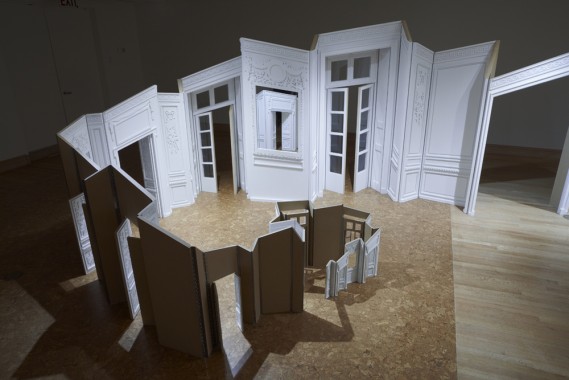Katrin Sigurdardottir On Drawing and Sculpting Space

Katrín Sigurðardóttir is premiering her Creative Capital-supported project with “Supra Terram,” a site-specific installation at Parasol unit in London. Supra Terram—from the Latin term for “going above ground”—is a large grotto-like sculpture that extends through the ceiling of Parasol unit’s ground-floor gallery into the gallery space above.
Jenny Gill connected with Katrín to learn more about this project and her ongoing exploration of duality and shifting perspective in sculptural installations.
Jenny Gill: Much of your work is site-specific and architectural in nature. Can you talk about the interplay between sculpture and architecture in your work?
Katrín Sigurðardóttir: I am primarily interested in the notion of place, and place is manifested in natural or man-made topography. I use architectural techniques and technologies to describe places; I am less interested in architecture as a means to solve problems, spatial or functional. And even if I am of course concerned with how materials build up, I see this as a basic concern in sculpture. I don’t know if I approach materials or structure in the same way an architect would.
I have enjoyed very much collaborating with architects and I think this excitement has been mutual, and it lies much within the fact that we look very differently at the same phenomena. All my sculptural work is heavily based in drawing, surveying of space, so perhaps my methodology is not unlike that of an architect in this regard, but just to a different end.
Jenny: Supra Terram will bisect the two floors of the Parasol unit gallery, creating two very different spaces in which viewers can interact with the work. Can you describe those spaces and what the experience of moving between them will be like for gallery visitors?
Katrín: First of all I expect the space will appear bare. I expect that the piece will speak to the space, and in some way render it different—perhaps it will feel smaller. There is a lot of empty space in this show, a vacuity that the visitor must confront and come to terms with. The piece itself can be seen as a meter, both for the space and for the body of the visitor. Downstairs, the piece is much larger than the visitor, but upstairs, the same entity is presented as much smaller than her/him. The viewer faces the same cavity, but in one space must regard it as an engulfment, and in the other, as an object. I have for a long time been interested in this problem: how to create a sculpture that is simultaneously experienced as an object and an environment.
Jenny: What has your process been like in designing and now fabricating this massive sculpture? As with the form itself, did you tailor the materials you’re using to the space?
Katrín: This sculpture has been in development for over two years. I made some early sketches of a large self-supporting cave in an exhibition space as far back as 2011. In 2013 I started developing this idea for Parasol unit. First there was a phase of designing the shape in a maquette, which then was sent from my studio in New York to London, where it has been scanned and turned into a computer model and then outputted to a CNC machine. The plywood ribs are then hand assembled and the process following this assembly turns back to basic materials applied by hand. I chose to use materials that are somewhat provisional and unprecious. There is something akin to a line drawing in this work. The line itself has no body, is immaterial, is only a divider of planes/spheres, a delineator of shapes. I think of the material in this sculpture much the same way.
Jenny: What other projects do you have in the works right now?
Katrín: I have recently finished a large survey of two series of my sculptures over the last 10 years, at The List Visual Arts Center at MIT in Cambridge, MA, curated by Paul Ha and Jeffrey DeBlois. Presently I have a sculpture in the exhibition Panorama, on the High Line, New York, curated by Cecilia Alemani. Upcoming are a large installation at Mass MoCA, curated by Susan Cross, and exhibitions in Reykjavík and San Francisco are also in the works for 2015 and 2016.
Jenny: Do you have any advice for younger artists who are just starting out?
Katrín: You must give absolute priority to the making of your work. It is your duty and you must serve it and always be its advocate. Believe in your process and your instinct. Free yourself from the impositions of other people’s judgement, opinions and conveniences. You are as free as you allow yourself to be.
“Katrín Sigurðardóttir: Supra Terram” is on view at Parasol unit in London, June 12 – August 8, 2015


